ISSN ONLINE(2319-8753)PRINT(2347-6710)
ISSN ONLINE(2319-8753)PRINT(2347-6710)
| K. Shanmugasundaram, B. Janarthanan Department of Physics, Karpagam University, Coimbatore, Tamilnadu, India |
| Related article at Pubmed, Scholar Google |
Visit for more related articles at International Journal of Innovative Research in Science, Engineering and Technology
In this paper, an attempt has been made to enhance the productivity of the single basin double slope solar still by integrating with shallow solar pond. The performance of the single basin double slope solar still integrated with shallow solar pond has been analyzed theoretically and experimentally. The experiments have been carried out from January to march 2012. The energy balance equations have been written for different temperature elements of the solar still such as glass cover, basin water and still basin. A computer program has been written for analytical solutions of the energy balance equations to evaluate the numerical results of the elements of the still. The productivity and efficiency of the solar still integrated with and without shallow solar pond has been found. It is found that the productivity of the solar still integrated with shallow sola pond is increased compared with the still without integration. The productivity of the solar still integrated with and without shallow solar pond is found to be 5.09 L/m2day and 3.17 L/m2day and the theoretical results are in good agreement with the experimental results.
Keywords |
| Renewable Energy, Desalination, Solar Still, Shallow Solar Pond, Heat exchanger. |
INTRODUCTION |
| Water is an essential for the maintenance of life and also the key to human’s prosperity. Solar desalination method is a process of obtaining pure water from waste /brackish or saline water using solar energy. The instantaneous thermal efficiency of an active solar still has been presented by Tiwari et al., [1] and inferred that the instantaneous thermal efficiency of the system decreases with an increase of collector area. The effect of coupling a flat-plate collector on the solar still productivity has been investigated experimentally by Badran and Al-Tahaineh [2]. It was found that the productivity of the solar still is increased by 36% when coupled with solar collectors. Velmurugan and Srithar [3] have presented a comparison between theoretical and experimental results of a mini solar pond assisted solar still. It has been found that the daily average production of solar still is increased. El-Sebaii et al. [4] have made an attempt to improve the productivity of the single effect solar still by integrating with shallow solar pond. The productivity and efficiency of the single effect solar still integrated with shallow solar pond have found to be higher than that of still without shallow solar pond. Velmurugan et al., [5] have integrated a stepped solar still and single basin solar still in series with a mini solar pond for the enhancement of productivity of solar still and found that the productivity and daily efficiency of the still have been increased significantly. The effect of coupling a flat-plate solar collector on the productivity of simple basin solar still has been investigated by Jadhav Madhav [6]. It was found that the maximum hourly distillate water productivity of simple basin solar still is 0.389L/m2hr and 1.150L/m2hr for solar still coupled with flat-plate collector. Kalidasa Murugavel et al., [7] have studied the effect of minimum depth of water on the performance of the solar still by spreading different materials in the basin. It is found that the still with ¾in.size quartzite rock is the effective basin materials for increased amount of distillate output. Ei-Sebaii et al. [8] have enhanced the productivity of single basin solar stills especially during the night by coupling a shallow solar pond to the solar still and concluded that the daily productivity and efficiency of the solar still decreases with increase of water mass in the basin and mass flow rate of the water flowing over the basin liner of the still. |
| Panchal [9] has studied the effect of various parameters on the performance of single basin double slope solar still. The productivity has been increased by using black dye in the basin water, sprinkler to increase the condensation rate and lower depth of water. Sampathkumar et al., [10] have studied the performance of the single basin solar still augmented with evacuated tubes and inferred that the daily production rate of the solar still is increased by 49.7% and increased by 59.48% by using black stones incorporated with evacuated tubes. Ajeet kumar [11] have made an attempt to find the optimum water depth and orientation for maximum yield of a double slope solar still. It has been concluded that the highest output corresponds to the minimum water depth and a gain of 60% to 65% of distillate output by orienting in the North- South directions. Sampathkumar et al., [12] have made an attempt to investigate a newly deign solar still coupled with an evacuated tube collector experimentally. It was found that the maximum productivity of the still is increased when coupled with evacuated tube collector. The maximum production rate of the solar still coupled with and without evacuated tube collector is found to be 7.03Kg/day and 3.225Kg/day. In the present work, an attempt has been made to improve the productivity of the double slope single basin solar still by integrating the shallow solar pond under the closed cycle mode of heat extraction. The performance of the solar still coupled with shallow solar pond has been investigated theoretically and experimentally. |
MATERIAL AND METHODS |
| Design of the system |
| The proposed double slope single basin solar still is coupled with a shallow solar pond (SSP). The schematic diagram of the single basin double slope solar still integrated with shallow solar pond is illustrated in Fig 1. A galvanized iron sheet is used for fabricating the still basin with an area of 1m2. The bottom and sides of the basin are insulated by ply wood and glass wool to minimize heat losses. The glass cover of thickness 4mm is used as the condensing surface and the slope of the glass cover are fixed as 110 which is equal to the latitude of the location (Coimbatore). The surface of the basin is painted black for maximum absorption of solar radiation. The solar still is oriented in North-South direction to receive solar radiation throughout the working hours of the day. |
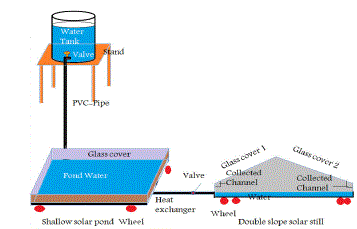 |
| The shallow solar pond is fabricated by using galvanized iron sheet with depth of 0.06 m and area of the bottom surface 1m2, which act as an absorbing surface for incident solar radiation. The bottom and sides of the pond are thermally insulated using glass wool to minimize heat losses. The thermal conductivity of the glass wool is 0.038 W/m K. The top of the pond is covered by two glass covers of thickness 4mm and the gap between two glass cover is 0.03m. The lower glass cover is always in contact with water so that no evaporation of water occurs; hence the cooling effect due to water evaporation is prevented. A linear array heat exchanger made of copper with length 0.12m and diameter of ½ inch is immersed in the pond water. The water is allowed to flow through the heat exchanger tube to extract heat from the pond under closed cycle mode. The water tank is fixed relatively at suitable height to achieve the required pressure. The outlet of the heat exchanger tutbe is connected to the inlet of the still. The solar still is placed at the same height as that of the pond. The temperature of the still basin, basin water and glass cover has been measured by fixed copper-constantan thermocouple which has been calibrated initially. Solar radiation intensity and ambient temperature have been measured with solar radiation monitor and digital thermometer. |
| Experiment have been carried out from 9am to 5pm with the solar still integrated with and without shallow solar pond at Department of Physics, Karpagam University, Coimbatore-641021 (latitude 110 N , long 770 52’ E). The photo graph of the single basin solar still integrated with shallow solar pond and without integration of the shallow solar pond is shown in the Figs 2. |
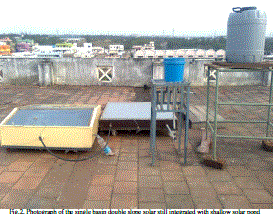 |
THERMAL MODELING |
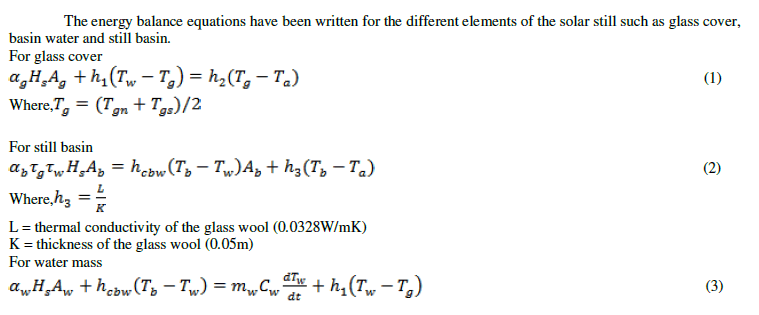 |
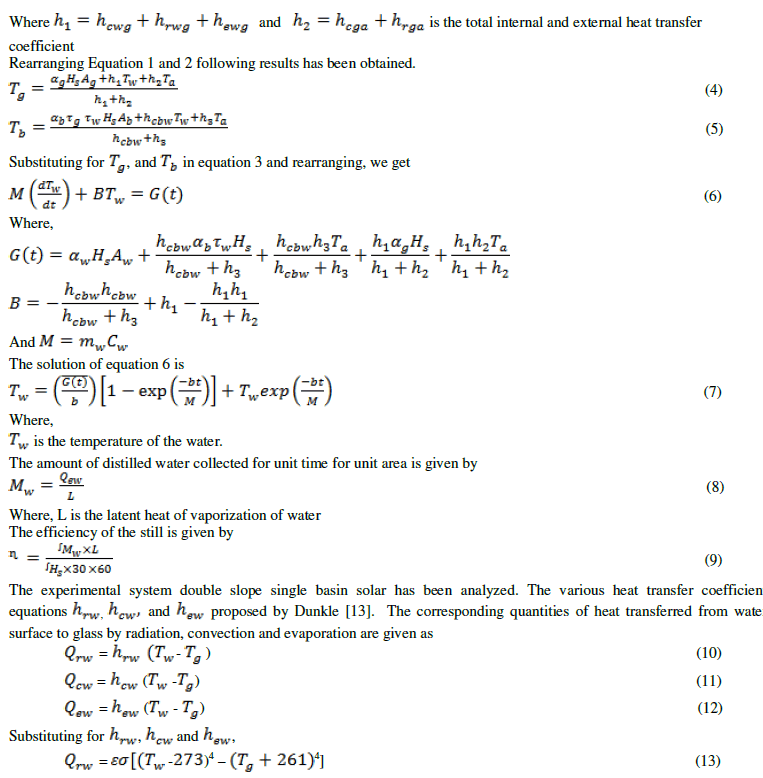 |
 |
RESULT AND DISCUSSION |
| The performance of the single basin double slope solar still integrated with shallow solar pond has been analyzed theoretically and experimentally. The experimental observation for the one of the typical days has been considered for the numerical calculations based on the analytical solutions of the temperature elements of the still. |
| Energy balance equations have been solved analytically for the temperature elements of the still and a computer program has been written and executed to find the theoretical results. The input parameters for the still including the climatic conditions are concerned for local conditions in Coimbatore, Tamilnadu and India (latitude-110 N, long-770 E) for the period January 2011-March 2011. The thermo physical parameters for the numerical solutions are shown in the Table 1. |
 |
| The variations of solar radiation intensity and ambient temperature for one of the typical days for with and without integration have been depicted in the Fig 3. From the figures it has been observed that the variation of solar radiation and ambient temperature for the typical days considered for with and without integration of solar pond has same trend. It is observed that the solar radiation intensity is gradually increased and reaches maximum during 12pm to 1pm and then decreased gradually. The maximum value of the solar radiation and ambient temperature is 1258 W/m2 and 400 C obtained. |
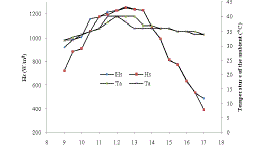 |
| Fig 4. Show the variation of glass cover and basin water temperature of the proposed still without integration and with integration of solar pond. It is observed that the glass cover temperature of the still when integrated with shallow solar pond is higher than the still without integration. It is due to the fact that the internal convective, evaporative and Radiative heat transfer from water to glass cover is high as the preheated water from the pond is provided as the input for the still in the case of integration of solar pond with the still. The glass cover and water temperature reached the maximum value of 480 and 460 at 13 hrs with and without the integration of solar pond with the still. Moreover, in the case of solar still without the integration of solar pond, thermal capacity plays a vital role for convective, Radiative and evaporative heat transfer from water to glass cover. Since the thermal capacity is high, more time has been taken for evaporation, convection and radiation. |
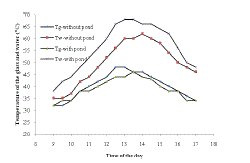 |
| From the Fig 4. it is also concluded that the auxiliary heat is gained by the saline water from the pond and fed to the still as input, when the still is integrated with solar pond and the preheated saline water absorbs energy from the direct solar radiation passing inside the still. The maximum temperature of the water without shallow solar pond was recorded as 62Ãâ¹ÃÅ¡C and with shallow solar pond 68Ãâ¹ÃÅ¡C during the working hours of the day. Comparing the temperature difference between the glass cover and water temperature in the two modes, it has been confirmed that throughout the working hours of the day, the difference in temperature is higher for the still when integrated with the pond. |
| The variation of saline water temperature from the heat exchanger tube immersed in shallow solar pond has been depicted in Fig 5. During morning hours, the extraction of heat from the pond by saline water through the heat exchanger tube is moderate and it gradually increases. The maximum saline water temperature is found to be 50ïÃâðC and heat energy extracted from pond water is given as input to the still throughout the working hours of the day. Though the auxiliary heat gained by the saline water is low during morning hours, the heat energy extracted is used to enhance the evaporation rate in the still. In the evening hours, heat energy extracted from the pond is high and it is utilized for evaporation when the intensity of solar radiation starts decreasing. |
| Comparisons have been made for the experimental distillate output from the still with and without the integration of solar pond. Fig 6. Show the variation of the observed distillate yield for two modes. Throughout the working hours of the still, it has been observed the total amount of distillate yield is higher in the case of still coupled with pond. Moreover, the night time collection of the still coupled with the pond is 1.250 liters and higher than the still without integration, i.e., 0.600 liters. This is due to the fact that thermal energy stored in the pond has been extracted using the heat exchanger tube during night time. Fig 7. Shows the comparisons of distilled water output in liters coupled with and without solar pond. For solar still coupled with solar pond, the distilled water output in liters is found to be 5.09 L/m2 during 9am to 5pm and collection of 1.250 liters with total of 6.34 liters/day and for a solar still without the integration of solar pond, distilled output in liters is found to be 3.17 L/m2 during 9am to 5 pm and night time collection of 0.600 liters with total of 2.700 liters/day. |
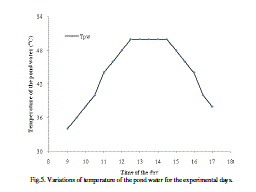 |
| Comparison of efficiency of the solar still with and without integration of solar pond is depicted in Fig 8. It is found that the instantaneous efficiency of the solar still with solar pond is found to be higher than the efficiency of solar still without solar pond. The maximum instantaneous efficiency for the solar still without solar pond is found to be 48% and for solar still with solar pond is found to be 65% respectively. |
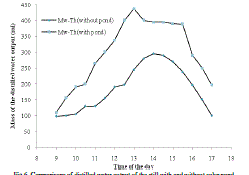 |
VALIDATION OF THE MODEL |
| Since the performance of the still integrated with the solar pond is better than the still without the pond, the analytical solutions of the temperature elements of the still has been taken to validate with the experimental observations. |
| Theoretical and experimental value of the glass cover and water temperature of the still integrated with shallow solar pond for one of the experimental days is depicted in Fig 9. It was found that the theoretical results are in good agreement with the experimental results. From the graph, it is observed that the theoretical results for water temperature is in close agreement with the experimental observations and regarding glass cover temperature, there exists some domination of the experimental observations due to the influence of climatic parameters such as clouds and wind etc. |
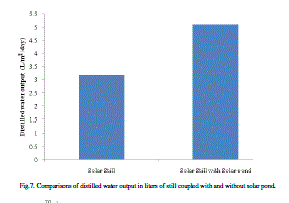 |
| The theoretical and experimental distilled water output from the still after coupled with shallow solar pond is depicted in Fig 10. It is fund that the theoretical results are in good agreement with the experimental results. The amount of distilled water output is increased from morning due to evaporation rate of the water is increased when coupled with pond. |
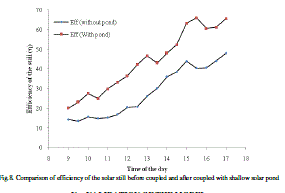 |
CONCLUSION |
| Based on these results the following conclusion has been drawn |
| 1. The performance of the solar still integrated with the shallow solar pond provides better performance compared with the still without integration. |
| 2. The total distillate yield of the still with pond is found to be 6.340 liters/day. |
| 3. The efficiency of the double slope single basin solar still is increased when coupled with shallow solar pond. It has shown great potential in terms of higher distillate yield per unit area and its operation process is very steady. The maximum instantaneous efficiency of the solar still coupled with and without shallow solar pond was found to be 48% and 65%. |
| 4. The solar still can be used as a water purifier for domestic purposes by using solar energy in winter and summer seasons. |
| 5. Though the still has been analyzed during the months January to March, it is possible to find the performance of the still can be found by using the proposed thermal model. |
NOMENCLATURE AND UNITS |
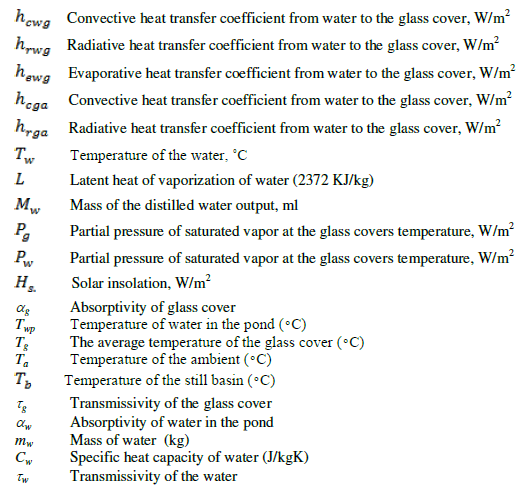 |
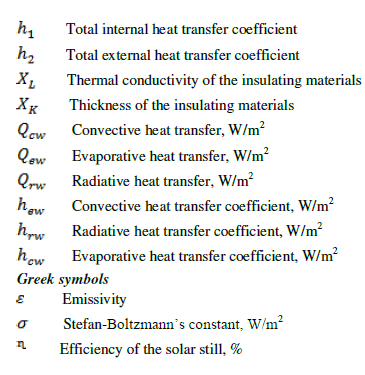 |
ACKNOWLEDGEMENT |
| The authors would like to thank University Grand Commission (UGC), The Government of India, New Delhi, for the award of Rajiv Gandhi National Research Fellowship (JRF). |
References |
|